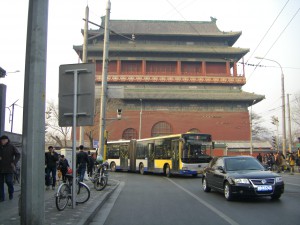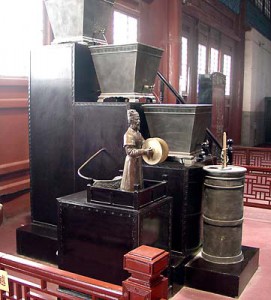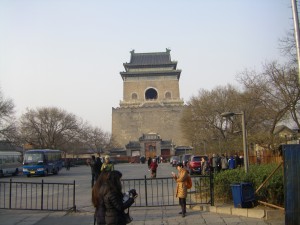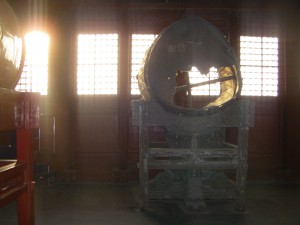Like each other old city in China, Beijing (北京) has one drum and one bell tower. They are situated at the northern end of the Zhongzhou road (中轴线); literally meaning: central axis of the inner city.
Zhongzhou Road is not the name of any particular road; it refers to the trunk road from Beichen Bridge on the northern 4th ring through to Zhonglou North Bridge on the northern 2nd ring (north stretch) and south of Yongdingmen (south stretch).
From 1267 to 1274 Liu Bingzhong (刘秉忠) planned and built the city of Dadu (大都), today Beijing. He also was responsible for the official buildings of the city.
The drum tower and bell tower were built in 1272 during the reign of Kublai Khan. At that time they stood at the very heart of Dadu city. The drum tower (鼓楼 Gǔlóu) also was called tower of orderly administration (齐政楼 qi zheng lou). In 1420, under Yongle emperor of the Ming dynasty the building was reconstructed to the east of the original site.

The drums and bells announced when it was time to wake up the workers and at midnight, when the gates were closed. The drums also announce the opening and closing markets.
The drum tower is equipped with a water clock (clepsydra). The clock was regulated by the flow of water between the three buckets arranged in a staircase.

On the sound of the drums, eleven gates around the outer city wall, the gates of the Imperial city and the gates fo the palace city would be opened and closed in a clockwise fashion.
The palace gates would always open last and close first as a symbol of the emperor’s power.

The Chinese idiom morning bell and dusk drum refers to the custom of the guard opening the gates on the city wall on the toll of the morning bell and closing them on the strike of evening drum.
The bell tower (钟楼 Zhōnglóu) stands closely behind the drum tower. Together, the bell tower and drum tower have panoramic views over central Beijing and before the modern era, they both dominated Beijing’s ancient skyline.

The bell and drum towers continued to function as the official timepiece of Beijing till 1924, when the last emperor of the Qing dynasty was forced to leave the Forbidden city and western-style clockwork was made the official meaning of time-keeping.
